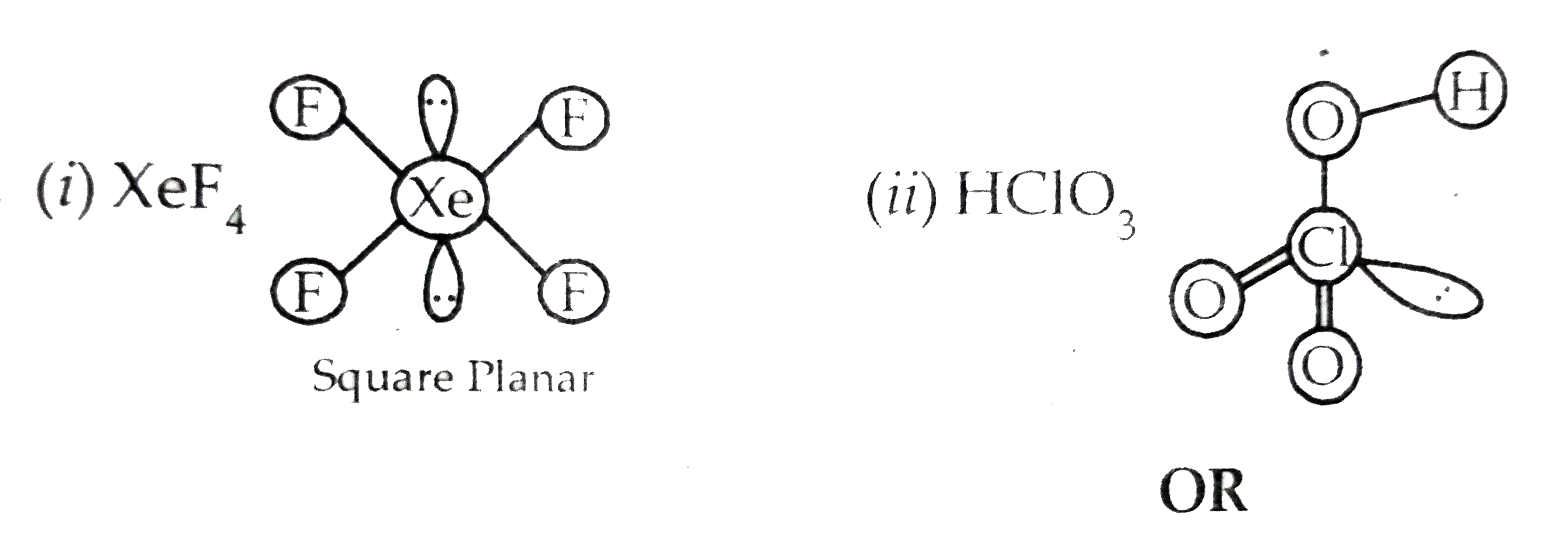(a) Give reasons :
(i) H3PO3 undergoes disproportionation reaction but H3PO4 does not .
(ii) When Cl2 reacts with excess of F2,ClF3 is formed and not FCl3.
(iii) Dioxygen is a gas while Sulphur is a solid at room temperature .
(b) Draw the structure of the following :
(i) XeF4 (ii)HClO3
Video Solution
Text Solution
(a) (i) It is because in H3PO3 , 'P' is in +3 , intermediate oxidation state which can increase to +5 and decrease to −3 where as in H3PO4 , 'P' is in highest oxidation state +5 which can only gain electrons , i.e., undergoes reduction only , acts as oxidising agent and cannot disproportionate .
(ii) As chlorine has vacant d-orbitals and hence show an oxidation state of +3 but F has no d-orbitals , therefore , it cannot show positive oxidation states . Further , since F can show only-1 oxidation state . Hence state . Hence , it can form only ClF3 and FCl3. Moreover , because of bigger size , Cl can accommodate 3 small F atoms around it while F being smaller cannot accommodate three bigger sized Cl atoms around it .
(iii) Due to small size , high electronegativity , oxygen forms Pπ−Pπ multiple bond . As a result , oxygen exists as O2 molecules , which are held together by weak van der waals forces of attraction which can be easily overcome at room temperature . Hence O2 is a gas at room temperature . Sulphur on the other hand , bigger size and lower electronegativity , does not form Pπ−Pπ multiple bond .
Hence it forms S-S single bonds which is stronger bond and has tendency of catenation and exist as in S8 form . Because of bigger size , the forces of attraction holding the S8 molecules together are much stronger which cannot be overcome at room temperature . Consequently , sulphur is a solid at room temperature.
(b) (i) XeF4 
|
Updated on:21/07/2023
Topper's Solved these Questions
- BOOK - XII BOARDS PREVIOUS YEARCHAPTER - XII BOARDSEXERCISE - OUTSIDE DELHI (SET-I)35videos
XII BOARDS
- BOOK - XII BOARDS PREVIOUS YEARCHAPTER - XII BOARDSEXERCISE - Set I31videos
XII BOARDS
- BOOK - XII BOARDS PREVIOUS YEARCHAPTER - XII BOARDSEXERCISE - General Instrucations31videos
XII BOARDS
- BOOK - XII BOARDS PREVIOUS YEARCHAPTER - SAMPLE PAPER 2019EXERCISE - SECTION: D1videos
SAMPLE PAPER 2019
Similar Questions
H3PO3 undergoes disproportionation reaction but H3PO4 does not ? Explain.
View SolutionGive reasons:
H3PO3 undergoes disproportionstion reaction but H3PO4 does notView SolutionGive reasons:
When Cl2 reacts with excess of F2,CIF3 is formed and not FCl3.View SolutionGive the disproportionation reaction of H3PO3.
View SolutionGive the disproportionation reaction of H3PO3.
View SolutionDraw the structures of the following:
(i) ClF3 (ii) XeF4View SolutionGive the disproportionation reaction ofH3PO3
View SolutionDraw the structures of the following molecules :
(i)XeOF4,(ii) H3PO3View SolutionGive the disproportionation reaction of H3PO3.
View SolutionGive the disproportionation reaction of H3PO3.
View Solution

